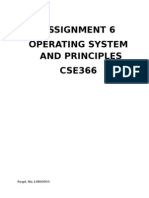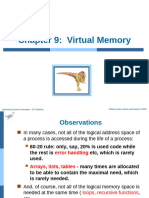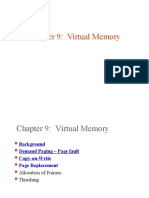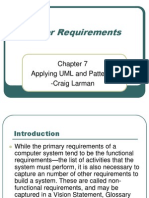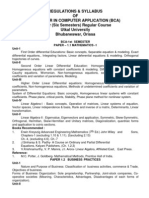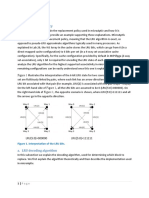Chapter 10: Virtual Memory
Chapter 10: Virtual Memory
Uploaded by
akbisoi1Copyright:
Available Formats
Chapter 10: Virtual Memory
Chapter 10: Virtual Memory
Uploaded by
akbisoi1Original Title
Copyright
Available Formats
Share this document
Did you find this document useful?
Is this content inappropriate?
Copyright:
Available Formats
Chapter 10: Virtual Memory
Chapter 10: Virtual Memory
Uploaded by
akbisoi1Copyright:
Available Formats
Silberschatz, Galvin and Gagne 2002 10.
1 Operating System Concepts
Chapter 10: Virtual Memory
Background
Demand Paging
Process Creation
Page Replacement
Allocation of Frames
Thrashing
Operating System Examples
Silberschatz, Galvin and Gagne 2002 10.2 Operating System Concepts
Background
Virtual memory separation of user logical memory
from physical memory.
Only part of the program needs to be in memory for
execution.
Logical address space can therefore be much larger than
physical address space.
Allows address spaces to be shared by several processes.
Allows for more efficient process creation.
Virtual memory can be implemented via:
Demand paging
Demand segmentation
Silberschatz, Galvin and Gagne 2002 10.3 Operating System Concepts
Virtual Memory That is Larger Than Physical Memory
Silberschatz, Galvin and Gagne 2002 10.4 Operating System Concepts
Demand Paging
Bring a page into memory only when it is needed.
Less I/O needed
Less memory needed
Faster response
More users
Page is needed reference to it
invalid reference abort
not-in-memory bring to memory
Silberschatz, Galvin and Gagne 2002 10.5 Operating System Concepts
Transfer of a Paged Memory to Contiguous Disk Space
Silberschatz, Galvin and Gagne 2002 10.6 Operating System Concepts
Valid-Invalid Bit
With each page table entry a validinvalid bit is
associated
(1 in-memory, 0 not-in-memory)
Initially validinvalid but is set to 0 on all entries.
Example of a page table snapshot.
During address translation, if validinvalid bit in page
table entry is 0 page fault.
1
1
1
1
0
0
0
Frame # valid-invalid bit
page table
Silberschatz, Galvin and Gagne 2002 10.7 Operating System Concepts
Page Table When Some Pages Are Not in Main Memory
Silberschatz, Galvin and Gagne 2002 10.8 Operating System Concepts
Page Fault
If there is ever a reference to a page, first reference will
trap to
OS page fault
OS looks at another table to decide:
Invalid reference abort.
Just not in memory.
Get empty frame.
Swap page into frame.
Reset tables, validation bit = 1.
Restart instruction: Least Recently Used
block move
auto increment/decrement location
Silberschatz, Galvin and Gagne 2002 10.9 Operating System Concepts
Steps in Handling a Page Fault
Silberschatz, Galvin and Gagne 2002 10.10 Operating System Concepts
What happens if there is no free frame?
Page replacement find some page in memory, but not
really in use, swap it out.
algorithm
performance want an algorithm which will result in
minimum number of page faults.
Same page may be brought into memory several times.
Silberschatz, Galvin and Gagne 2002 10.11 Operating System Concepts
Performance of Demand Paging
Page Fault Rate 0 s p s 1.0
if p = 0 no page faults
if p = 1, every reference is a fault
Effective Access Time (EAT)
EAT = (1 p) x memory access
+ p (page fault overhead
+ [swap page out ]
+ swap page in
+ restart overhead)
Silberschatz, Galvin and Gagne 2002 10.12 Operating System Concepts
Demand Paging Example
Memory access time = 1 microsecond
50% of the time the page that is being replaced has been
modified and therefore needs to be swapped out.
(50% * 10000 for swapping a page out + 100% * 10000
for swapping a page in = 15000)
Swap Page Time = 10 msec = 10,000 microsec
EAT = (1 p) x 1 + p (15000)
= 1 + 14999P (in microsec)
Silberschatz, Galvin and Gagne 2002 10.13 Operating System Concepts
Process Creation
Virtual memory allows other benefits during process
creation:
- Copy-on-Write
- Memory-Mapped Files
Silberschatz, Galvin and Gagne 2002 10.14 Operating System Concepts
Copy-on-Write
Copy-on-Write (COW) allows both parent and child
processes to initially share the same pages in memory.
If either process modifies a shared page, only then is the
page copied.
COW allows more efficient process creation as only
modified pages are copied.
Free pages are allocated from a pool of zeroed-out
pages.
Silberschatz, Galvin and Gagne 2002 10.15 Operating System Concepts
Memory-Mapped Files
Memory-mapped file I/O allows file I/O to be treated as routine
memory access by mapping a disk block to a page in memory.
A file is initially read using demand paging. A page-sized portion
of the file is read from the file system into a physical page.
Subsequent reads/writes to/from the file are treated as ordinary
memory accesses.
Simplifies file access by treating file I/O through memory rather
than read() write() system calls.
Also allows several processes to map the same file allowing the
pages in memory to be shared.
Silberschatz, Galvin and Gagne 2002 10.16 Operating System Concepts
Memory Mapped Files
Silberschatz, Galvin and Gagne 2002 10.17 Operating System Concepts
Page Replacement
Prevent over-allocation of memory by modifying page-
fault service routine to include page replacement.
Use modify (dirty) bit to reduce overhead of page
transfers only modified pages are written to disk.
Page replacement completes separation between logical
memory and physical memory large virtual memory can
be provided on a smaller physical memory.
Silberschatz, Galvin and Gagne 2002 10.18 Operating System Concepts
Need For Page Replacement
Silberschatz, Galvin and Gagne 2002 10.19 Operating System Concepts
Basic Page Replacement
1. Find the location of the desired page on disk.
2. Find a free frame:
- If there is a free frame, use it.
- If there is no free frame, use a page replacement
algorithm to select a victim frame.
3. Read the desired page into the (newly) free frame.
Update the page and frame tables.
4. Restart the process.
Silberschatz, Galvin and Gagne 2002 10.20 Operating System Concepts
Page Replacement
Silberschatz, Galvin and Gagne 2002 10.21 Operating System Concepts
Page Replacement Algorithms
Want lowest page-fault rate.
Evaluate algorithm by running it on a particular string of
memory references (reference string) and computing the
number of page faults on that string.
In all our examples, the reference string is
1, 2, 3, 4, 1, 2, 5, 1, 2, 3, 4, 5.
Silberschatz, Galvin and Gagne 2002 10.22 Operating System Concepts
Graph of Page Faults Versus The Number of Frames
Silberschatz, Galvin and Gagne 2002 10.23 Operating System Concepts
First-In-First-Out (FIFO) Algorithm
Reference string: 1, 2, 3, 4, 1, 2, 5, 1, 2, 3, 4, 5
3 frames (3 pages can be in memory at a time per
process)
4 frames
FIFO Replacement Beladys Anomaly
more frames less page faults
1
2
3
1
2
3
4
1
2
5
3
4
9 page faults
1
2
3
1
2
3
5
1
2
4
5
10 page faults
4
4 3
Silberschatz, Galvin and Gagne 2002 10.24 Operating System Concepts
FIFO Page Replacement
Silberschatz, Galvin and Gagne 2002 10.25 Operating System Concepts
FIFO Illustrating Beladys Anamoly
Silberschatz, Galvin and Gagne 2002 10.26 Operating System Concepts
Optimal Algorithm
Replace page that will not be used for longest period of
time.
4 frames example
1, 2, 3, 4, 1, 2, 5, 1, 2, 3, 4, 5
How do you know this?
Used for measuring how well your algorithm performs.
1
2
3
4
6 page faults
4
5
Silberschatz, Galvin and Gagne 2002 10.27 Operating System Concepts
Optimal Page Replacement
Silberschatz, Galvin and Gagne 2002 10.28 Operating System Concepts
Least Recently Used (LRU) Algorithm
Reference string: 1, 2, 3, 4, 1, 2, 5, 1, 2, 3, 4, 5
Counter implementation
Every page entry has a counter; every time page is
referenced through this entry, copy the clock into the
counter.
When a page needs to be changed, look at the counters to
determine which are to change.
1
2
3
5
4
4
3
5
Silberschatz, Galvin and Gagne 2002 10.29 Operating System Concepts
LRU Page Replacement
Silberschatz, Galvin and Gagne 2002 10.30 Operating System Concepts
LRU Algorithm (Cont.)
Stack implementation keep a stack of page numbers in
a double link form:
Page referenced:
move it to the top
requires 6 pointers to be changed
No search for replacement
Silberschatz, Galvin and Gagne 2002 10.31 Operating System Concepts
Use Of A Stack to Record The Most Recent Page References
Silberschatz, Galvin and Gagne 2002 10.32 Operating System Concepts
LRU Approximation Algorithms
Reference bit
With each page associate a bit, initially = 0
When page is referenced bit set to 1.
Replace the one which is 0 (if one exists). We do not know
the order, however.
Second chance
Need reference bit.
Clock replacement.
If page to be replaced (in clock order) has reference bit = 1.
then:
set reference bit 0.
leave page in memory.
replace next page (in clock order), subject to same
rules.
Silberschatz, Galvin and Gagne 2002 10.33 Operating System Concepts
Second-Chance (clock) Page-Replacement Algorithm
Silberschatz, Galvin and Gagne 2002 10.34 Operating System Concepts
Counting Algorithms
Keep a counter of the number of references that have
been made to each page.
LFU Algorithm: replaces page with smallest count.
MFU Algorithm: based on the argument that the page
with the smallest count was probably just brought in and
has yet to be used.
Silberschatz, Galvin and Gagne 2002 10.35 Operating System Concepts
Allocation of Frames
Each process needs minimum number of pages.
Example: IBM 370 6 pages to handle SS MOVE
instruction:
instruction is 6 bytes, might span 2 pages.
2 pages to handle from.
2 pages to handle to.
Two major allocation schemes.
fixed allocation
priority allocation
Silberschatz, Galvin and Gagne 2002 10.36 Operating System Concepts
Fixed Allocation
Equal allocation e.g., if 100 frames and 5 processes,
give each 20 pages.
Proportional allocation Allocate according to the size of
process.
m
S
s
p a
m
s S
p s
i
i i
i
i i
= =
=
=
=
for allocation
frames of number total
process of size
59 64
137
127
5 64
137
10
127
10
64
2
1
2
~ =
~ =
=
=
=
a
a
s
s
m
i
Silberschatz, Galvin and Gagne 2002 10.37 Operating System Concepts
Priority Allocation
Use a proportional allocation scheme using priorities
rather than size.
If process P
i
generates a page fault,
select for replacement one of its frames.
select for replacement a frame from a process with lower
priority number.
Silberschatz, Galvin and Gagne 2002 10.38 Operating System Concepts
Global vs. Local Allocation
Global replacement process selects a replacement
frame from the set of all frames; one process can take a
frame from another.
Local replacement each process selects from only its
own set of allocated frames.
Silberschatz, Galvin and Gagne 2002 10.39 Operating System Concepts
Thrashing
If a process does not have enough pages, the page-
fault rate is very high. This leads to:
low CPU utilization.
operating system thinks that it needs to increase the degree
of multiprogramming.
another process added to the system.
Thrashing a process is busy swapping pages in and
out.
Silberschatz, Galvin and Gagne 2002 10.40 Operating System Concepts
Thrashing
Why does paging work?
Locality model
Process migrates from one locality to another.
Localities may overlap.
Why does thrashing occur?
E size of locality > total memory size
Silberschatz, Galvin and Gagne 2002 10.41 Operating System Concepts
Locality In A Memory-Reference Pattern
Silberschatz, Galvin and Gagne 2002 10.42 Operating System Concepts
Working-Set Model
A working-set window a fixed number of page
references
Example: 10,000 instruction
WSS
i
(working set of Process P
i
) =
total number of pages referenced in the most recent A
(varies in time)
if A too small will not encompass entire locality.
if A too large will encompass several localities.
if A = will encompass entire program.
D = E WSS
i
total demand frames
if D > m Thrashing
Policy if D > m, then suspend one of the processes.
Silberschatz, Galvin and Gagne 2002 10.43 Operating System Concepts
Working-set model
Silberschatz, Galvin and Gagne 2002 10.44 Operating System Concepts
Keeping Track of the Working Set
Approximate with interval timer + a reference bit
Example: A = 10,000
Timer interrupts after every 5000 time units.
Keep in memory 2 bits for each page.
Whenever a timer interrupts copy and sets the values of all
reference bits to 0.
If one of the bits in memory = 1 page in working set.
Why is this not completely accurate?
Improvement = 10 bits and interrupt every 1000 time
units.
Silberschatz, Galvin and Gagne 2002 10.45 Operating System Concepts
Page-Fault Frequency Scheme
Establish acceptable page-fault rate.
If actual rate too low, process loses frame.
If actual rate too high, process gains frame.
Silberschatz, Galvin and Gagne 2002 10.46 Operating System Concepts
Other Considerations
Prepaging
Page size selection
fragmentation
table size
I/O overhead
locality
Silberschatz, Galvin and Gagne 2002 10.47 Operating System Concepts
Other Considerations (Cont.)
TLB Reach - The amount of memory accessible from the
TLB.
TLB Reach = (TLB Size) X (Page Size)
Ideally, the working set of each process is stored in the
TLB. Otherwise there is a high degree of page faults.
Silberschatz, Galvin and Gagne 2002 10.48 Operating System Concepts
Increasing the Size of the TLB
Increase the Page Size. This may lead to an increase in
fragmentation as not all applications require a large page
size.
Provide Multiple Page Sizes. This allows applications
that require larger page sizes the opportunity to use them
without an increase in fragmentation.
Silberschatz, Galvin and Gagne 2002 10.49 Operating System Concepts
Other Considerations (Cont.)
Program structure
int A[][] = new int[1024][1024];
Each row is stored in one page
Program 1 for (j = 0; j < A.length; j++)
for (i = 0; i < A.length; i++)
A[i,j] = 0;
1024 x 1024 page faults
Program 2 for (i = 0; i < A.length; i++)
for (j = 0; j < A.length; j++)
A[i,j] = 0;
1024 page faults
Silberschatz, Galvin and Gagne 2002 10.50 Operating System Concepts
Other Considerations (Cont.)
I/O Interlock Pages must sometimes be locked into
memory.
Consider I/O. Pages that are used for copying a file from
a device must be locked from being selected for eviction
by a page replacement algorithm.
Silberschatz, Galvin and Gagne 2002 10.51 Operating System Concepts
Reason Why Frames Used For I/O Must Be In Memory
Silberschatz, Galvin and Gagne 2002 10.52 Operating System Concepts
Operating System Examples
Windows NT
Solaris 2
Silberschatz, Galvin and Gagne 2002 10.53 Operating System Concepts
Windows NT
Uses demand paging with clustering. Clustering brings
in pages surrounding the faulting page.
Processes are assigned working set minimum and
working set maximum.
Working set minimum is the minimum number of pages
the process is guaranteed to have in memory.
A process may be assigned as many pages up to its
working set maximum.
When the amount of free memory in the system falls
below a threshold, automatic working set trimming is
performed to restore the amount of free memory.
Working set trimming removes pages from processes that
have pages in excess of their working set minimum.
Silberschatz, Galvin and Gagne 2002 10.54 Operating System Concepts
Solaris 2
Maintains a list of free pages to assign faulting processes.
Lotsfree threshold parameter to begin paging.
Paging is peformed by pageout process.
Pageout scans pages using modified clock algorithm.
Scanrate is the rate at which pages are scanned. This
ranged from slowscan to fastscan.
Pageout is called more frequently depending upon the
amount of free memory available.
Silberschatz, Galvin and Gagne 2002 10.55 Operating System Concepts
Solar Page Scanner
You might also like
- FreeRTOS Interview Questions 1695641047Document21 pagesFreeRTOS Interview Questions 1695641047Ahmed HamdiNo ratings yet
- 8.11 Given Six Memory Partitions of 300KB, 600KB, 350KB, 200KBDocument20 pages8.11 Given Six Memory Partitions of 300KB, 600KB, 350KB, 200KBAnshita VarshneyNo ratings yet
- Virtual MemoryDocument36 pagesVirtual MemoryTanvir DhanjuNo ratings yet
- Operating Systems Chapter 10 Virtual Memory SlidesDocument53 pagesOperating Systems Chapter 10 Virtual Memory SlidesMatt SchnurNo ratings yet
- Memory and Device ManagementDocument27 pagesMemory and Device ManagementRahul KumarNo ratings yet
- Chapter 9: Virtual Memory: Silberschatz, Galvin and Gagne ©2013 Operating System Concepts - 9 EditionDocument78 pagesChapter 9: Virtual Memory: Silberschatz, Galvin and Gagne ©2013 Operating System Concepts - 9 EditionVenkatesh Nanneboina100% (1)
- Virtual MemoryDocument36 pagesVirtual Memorysmritieligar2004No ratings yet
- Virtual Memory: Module - 3Document27 pagesVirtual Memory: Module - 3Subasish NayakNo ratings yet
- Unit 4 Virtual Memory (Second Part)Document31 pagesUnit 4 Virtual Memory (Second Part)RishiNo ratings yet
- Virtual Memory - CH 10Document56 pagesVirtual Memory - CH 10Ravinder K SinglaNo ratings yet
- 2.virtualmemoryDocument47 pages2.virtualmemoryAngelin Beulah ShirlyNo ratings yet
- Os Chapter 9Document36 pagesOs Chapter 9shubhranshi.23hcs4149No ratings yet
- CH 91Document52 pagesCH 91younas125No ratings yet
- Operating Systems Concepts 9th Edition Chapter9Document77 pagesOperating Systems Concepts 9th Edition Chapter9yankevNo ratings yet
- Edited From Slides For Operating System Concepts by Silberschatz, Galvin, GagneDocument35 pagesEdited From Slides For Operating System Concepts by Silberschatz, Galvin, Gagneebin josephNo ratings yet
- Lecture#10 12Document63 pagesLecture#10 12Fatima MalickNo ratings yet
- Nav 6Document6 pagesNav 6shailesh singhNo ratings yet
- Chapter 10Document7 pagesChapter 10Stanislau DevNo ratings yet
- Background Demand Paging Process Creation Page Replacement Allocation of Frames Thrashing Operating System ExamplesDocument21 pagesBackground Demand Paging Process Creation Page Replacement Allocation of Frames Thrashing Operating System ExamplesUjjawal MallikNo ratings yet
- CH 09Document60 pagesCH 09surajraut8586No ratings yet
- Virtual MemoryDocument28 pagesVirtual MemoryJainendra GautamNo ratings yet
- Effective Access Time How Often Do We Want Page Faults?: If P 0 No Page Faults If P 1, Every Reference Is A FaultDocument5 pagesEffective Access Time How Often Do We Want Page Faults?: If P 0 No Page Faults If P 1, Every Reference Is A FaultOmkar PathakNo ratings yet
- Virtual Memory Page ReplacementDocument40 pagesVirtual Memory Page ReplacementRajeevDutt0% (1)
- Virtual MemoryDocument11 pagesVirtual Memorybalabhaskar mandalaNo ratings yet
- Chapter 9 - Virtual Memory Background: Prepared by Dr. Amjad MahmoodDocument16 pagesChapter 9 - Virtual Memory Background: Prepared by Dr. Amjad MahmoodAmeen MtNo ratings yet
- Virtual MemoryDocument36 pagesVirtual MemoryumeshNo ratings yet
- CH 08Document36 pagesCH 08Nora Al-MansourNo ratings yet
- Virtual Memory ManagementDocument25 pagesVirtual Memory ManagementAyushi TodiNo ratings yet
- Chapter 9-Virtual Memory - UpdatedDocument106 pagesChapter 9-Virtual Memory - Updated70131290No ratings yet
- Lecture-39 memory managementDocument24 pagesLecture-39 memory managementSaksham WaneNo ratings yet
- Week 10 CH 9 VirtualMemoryDocument7 pagesWeek 10 CH 9 VirtualMemoryAdnan Alam KhanNo ratings yet
- Background Swapping Contiguous Allocation Paging Segmentation Segmentation With PagingDocument54 pagesBackground Swapping Contiguous Allocation Paging Segmentation Segmentation With PagingAlfons PérezNo ratings yet
- Unit 06 - Virtual MemoryDocument30 pagesUnit 06 - Virtual MemoryNaif AlajlaniNo ratings yet
- M4 Virtual Memory2Document50 pagesM4 Virtual Memory2yesorno9597No ratings yet
- Cs604 - Final Term Subjective With Reference Solved by Umair SaulatDocument29 pagesCs604 - Final Term Subjective With Reference Solved by Umair SaulatchiNo ratings yet
- CSE 120 Principles of Operating Systems: Fall 2014Document24 pagesCSE 120 Principles of Operating Systems: Fall 2014Adarsh SurendranNo ratings yet
- Paging Concept of Virtual Memory 2Document34 pagesPaging Concept of Virtual Memory 2kavinjothi18No ratings yet
- 20-ch9_part3Document27 pages20-ch9_part3otgameryt0No ratings yet
- ch9Document46 pagesch9REVOLVERNo ratings yet
- Module 4.3Document11 pagesModule 4.3dailybhaktifeedNo ratings yet
- Chapter 8: Virtual Memory: Silberschatz, Galvin and Gagne ©2009 Operating System Concepts - 8 EditionDocument50 pagesChapter 8: Virtual Memory: Silberschatz, Galvin and Gagne ©2009 Operating System Concepts - 8 Edition飞翔No ratings yet
- Os Unit 4Document14 pagesOs Unit 4Sahil PahwaNo ratings yet
- Vmemory SolDocument28 pagesVmemory SolSachinSubramanyaNo ratings yet
- Chapter 8: Main Memory: Silberschatz, Galvin and Gagne ©2009 Operating System Concepts - 8 EditionDocument57 pagesChapter 8: Main Memory: Silberschatz, Galvin and Gagne ©2009 Operating System Concepts - 8 EditionSubhadip Das SarmaNo ratings yet
- 2019 Spring OS Assignment # 4 VMMDocument8 pages2019 Spring OS Assignment # 4 VMMAsad AliNo ratings yet
- Chapter 9: Virtual Memory: Silberschatz, Galvin and Gagne ©2011 Operating System Concepts Essentials - 8 EditionDocument42 pagesChapter 9: Virtual Memory: Silberschatz, Galvin and Gagne ©2011 Operating System Concepts Essentials - 8 EditionManohar DattNo ratings yet
- Thrashing in OS (Operating System) - What Is Thrash - JavatpointDocument7 pagesThrashing in OS (Operating System) - What Is Thrash - JavatpointBhuvaneshNo ratings yet
- Chapter 9: Virtual MemoryDocument71 pagesChapter 9: Virtual MemoryAbhishek Samuel EdwinNo ratings yet
- Chapter 8: Main Memory: Silberschatz, Galvin and Gagne ©2009 Operating System Concepts - 8 EditionDocument46 pagesChapter 8: Main Memory: Silberschatz, Galvin and Gagne ©2009 Operating System Concepts - 8 EditionGul ZareenNo ratings yet
- Materi SO - 9Document69 pagesMateri SO - 9135 Novariya Br SaragihNo ratings yet
- 3q345fyijokpl (Document8 pages3q345fyijokpl (Soumyaprakash PaniNo ratings yet
- 10-1Document71 pages10-1drakekendrick40No ratings yet
- Virtual Memory Management-Operating SystemsDocument72 pagesVirtual Memory Management-Operating SystemsSanket Chavan100% (1)
- WeekDocument82 pagesWeekMaaz ChowdhryNo ratings yet
- Ch08 ReloadedDocument58 pagesCh08 ReloadedTrolRaja RaniNo ratings yet
- Chapter 12Document45 pagesChapter 12ManalAmerNo ratings yet
- CH 10Document28 pagesCH 10FilipLubniewskiNo ratings yet
- Chapter 9Document17 pagesChapter 9Pratap SinghNo ratings yet
- Week 14 - Internal OS (Part 2)Document30 pagesWeek 14 - Internal OS (Part 2)26txv47zk4No ratings yet
- Lecture#13 15Document55 pagesLecture#13 15Fatima MalickNo ratings yet
- PythonDocument44 pagesPythonakbisoi1No ratings yet
- An Introduction To Python Programming LanguageDocument63 pagesAn Introduction To Python Programming Languageakbisoi1No ratings yet
- Chapter 2 Inverse Trigonometric FunctionsDocument0 pagesChapter 2 Inverse Trigonometric FunctionsAkash ChatterjeeNo ratings yet
- Arithmetic & Logic UnitDocument58 pagesArithmetic & Logic Unitakbisoi1No ratings yet
- Larman Chapter 6Document56 pagesLarman Chapter 6toomy144No ratings yet
- Practice Problems 1Document34 pagesPractice Problems 1akbisoi1No ratings yet
- From Inception To Elaboration: Applying UML and Patterns - Craig LarmanDocument14 pagesFrom Inception To Elaboration: Applying UML and Patterns - Craig Larmanakbisoi1No ratings yet
- Domain Model: Visualizing Concepts: Applying UML and Patterns - Craig LarmanDocument13 pagesDomain Model: Visualizing Concepts: Applying UML and Patterns - Craig Larmanakbisoi1No ratings yet
- Larman Chapter 9Document27 pagesLarman Chapter 9akbisoi1No ratings yet
- Understanding Requirements: Applying UML and Patterns - Craig LarmanDocument8 pagesUnderstanding Requirements: Applying UML and Patterns - Craig Larmanakbisoi1No ratings yet
- Larman Chapter 7Document14 pagesLarman Chapter 7akbisoi1No ratings yet
- Unit 3 - Advanced Algorithms and Programming PrinciplesDocument15 pagesUnit 3 - Advanced Algorithms and Programming Principlesakbisoi1No ratings yet
- Larman Chapter 7Document14 pagesLarman Chapter 7akbisoi1No ratings yet
- Module Design Issues: MSWE607 - Fall 2000 - Slides 12 © M V Zelkowitz, 2000Document17 pagesModule Design Issues: MSWE607 - Fall 2000 - Slides 12 © M V Zelkowitz, 2000akbisoi1No ratings yet
- Utkal Bca SyllabusDocument19 pagesUtkal Bca Syllabusakbisoi1No ratings yet
- Lec 16 Metrics CohesionDocument22 pagesLec 16 Metrics Cohesionakbisoi1100% (1)
- Modularity and Coupling and Cohesion: SE464/CS446/ECE452Document30 pagesModularity and Coupling and Cohesion: SE464/CS446/ECE452admzaemNo ratings yet
- Coupling CohesionDocument28 pagesCoupling Cohesionakbisoi1No ratings yet
- 7 2-CohesionCouplingDocument2 pages7 2-CohesionCouplingakbisoi1No ratings yet
- 2.4GHz Wireless PresenterDocument1 page2.4GHz Wireless Presenterakbisoi1No ratings yet
- ICS 431-Ch14-File System ImplementationDocument29 pagesICS 431-Ch14-File System ImplementationThe Great HammerNo ratings yet
- RTOS For Embedded System Design: Mr. Anand H. DDocument128 pagesRTOS For Embedded System Design: Mr. Anand H. DKaran JagannathNo ratings yet
- Memory Segmentation Is The Division of ComputerDocument1 pageMemory Segmentation Is The Division of ComputerManoj Kumar GNo ratings yet
- 4.2.chuong4 - FreeRTOS - QUAN LY BO NHO - 2Document53 pages4.2.chuong4 - FreeRTOS - QUAN LY BO NHO - 2Thăng TrầnNo ratings yet
- TAFJ-AS WebLogicInstallDocument66 pagesTAFJ-AS WebLogicInstallS.M. SayeedNo ratings yet
- Module-5 2 4Document14 pagesModule-5 2 4SANYAM TYAGINo ratings yet
- GCTuning Presentation FISL10Document64 pagesGCTuning Presentation FISL10expostfacto100% (1)
- Java AssignmentDocument18 pagesJava Assignmentkarandeep singh aterNo ratings yet
- Problem Set 4Document4 pagesProblem Set 4john ham100% (1)
- Chapter 3 Memory ManagementDocument20 pagesChapter 3 Memory Managementvugutsaruth38No ratings yet
- Jprofiler InfoDocument7 pagesJprofiler InfoDebasis NayakNo ratings yet
- White Paper - QlikView Server Memory Management and CPU UtilizationDocument11 pagesWhite Paper - QlikView Server Memory Management and CPU UtilizationKilly BlameNo ratings yet
- Tutorial Sol 9Document5 pagesTutorial Sol 9Mudit SinhaNo ratings yet
- AACS2284 Tut 4 QuestionDocument8 pagesAACS2284 Tut 4 QuestionTEOH YING JINGNo ratings yet
- Feactures of RTOS and DOS OSY Project (AS)Document25 pagesFeactures of RTOS and DOS OSY Project (AS)Tanishka PatilNo ratings yet
- 20 Common Errors in Salesforce With Resolution 1720015105Document12 pages20 Common Errors in Salesforce With Resolution 1720015105gaurav.mishravnsNo ratings yet
- Pseudo LRUDocument6 pagesPseudo LRUJosé Miguel Hidalgo CamposNo ratings yet
- 02 Task Performance 1 - ARGDocument4 pages02 Task Performance 1 - ARGSean MaverickNo ratings yet
- Memory Management Issues: Inspire PosterityDocument24 pagesMemory Management Issues: Inspire PosterityzubairNo ratings yet
- EIE3343 Memory Management - Segmentation and PagingDocument62 pagesEIE3343 Memory Management - Segmentation and Pagingv2xv4p6pv8No ratings yet
- Dronacharya College of Engg. Gr. Noida: Questions For Sessional-II (CD)Document23 pagesDronacharya College of Engg. Gr. Noida: Questions For Sessional-II (CD)ziddirazan100% (1)
- OPERATING SYSTEMS Lecture Notes++Document47 pagesOPERATING SYSTEMS Lecture Notes++Lovemore MulengaNo ratings yet
- Unix Sheel ProgrammingDocument63 pagesUnix Sheel ProgrammingAKASH PAL100% (1)
- Process Description and Control: Operating Systems: Internals and Design PrinciplesDocument61 pagesProcess Description and Control: Operating Systems: Internals and Design PrinciplesMuhammad Adnan KhalidNo ratings yet
- The 80386 Microprocessor UpdatedDocument13 pagesThe 80386 Microprocessor UpdatedomNo ratings yet
- Python Quetion and AnswersDocument5 pagesPython Quetion and AnswersSancarapu NagarajuNo ratings yet
- BSGMM 4a Os A3 F22 017Document5 pagesBSGMM 4a Os A3 F22 017Abdul MoeidNo ratings yet
- Document 1516229.1Document10 pagesDocument 1516229.1ajfernandeztNo ratings yet
- Module2 2Document15 pagesModule2 2Sandip DasNo ratings yet
















